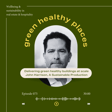Introduction and Welcoming Bernie
00:00:00
mattmorley
Bernie, thanks so much for joining us on the podcast today. Lovely to have you here.
00:00:05
Rainey Shane
Yeah, thank you for having me. I love doing podcasts.
00:00:09
mattmorley
but get Well, good. Well, let's jump in.
DEI vs Social Equity in Real Estate
00:00:11
mattmorley
So let's talk social equity and
00:00:16
mattmorley
dei So how do you how do you differentiate between these two concepts? Let's start with the basics. So these key concepts that we're going to be dealing with today, and especially because you're dealing with it in the framework of commercial real estate, which is kind of your thing. That's your special source. So let's talk a little bit about the key terms.
00:00:36
Rainey Shane
Yeah, so I could give you a very technical definition for what I consider DEI and what I consider social equity. I think though the definition changes depending on what country and what culture you're from. I also think that there's so much overlap between the two. One tends to look more internally DEI, right? Internally to the people in organizations and how how you're treating those people and social equity to me looks more externally at outcomes and impacts. However,
Critique of U.S. DEI Approaches
00:01:10
Rainey Shane
what I would say, and this might be a little comfort controversial, is that I think that's the wrong question to be asking. I think, especially in the United States, we attach all of these meanings to words, diversity, equity, um and they become what we ascribe to them and in the United States DEI is considered a bad word you know it's very split between political parties and so then we start to try to change our language and change the words that we're using because ultimately if we get down to the base principles we're all really saying the same thing I mean most humans agree that you should treat other humans
00:01:58
Rainey Shane
equitably. um So I think that we need to start creating a different argument around what we're calling these things and looking more at What are the principles that lead to the outcomes that we want? Because the reason that we have ascribed negative connotations to these words is we have been doing it wrong. At least in the United States, we've been doing DEI wrong. We're approaching it incorrectly.
Principle-based Social Initiatives
00:02:33
Rainey Shane
We're approaching it from a
00:02:35
Rainey Shane
a physical science quantitative measurement lens we skip over the principles of what leads us to the outcomes that we want and we go straight to some proxy quantitative measurement of something social that's really a qualitative measurement and and therefore we leave it to people to figure out how to get to that quantitative measure and if you don't give guidance on what ah what are the best practices and principles to get you there, people are just gonna take shortcuts and create all kinds of negative consequences. So I know that's a bit of a longer answer, um but I gave you kind of a technical and then also where I think we should be heading when we're talking about both social equity and DEI.
Community Impact of Real Estate
00:03:31
mattmorley
It's a great start. So why don't we then drill down into it and think about the problem that you're effectively trying to solve or a solution that you're offering to a specific problem because What would you consider using your terms to be like the impact map of commercial real estate? Like for someone who perhaps doesn't necessarily know what the potential risks or issues are to do with commercial real estate and social equity, like how do you see that? What are the key areas that you're thinking about and the solutions that you're providing for them?
00:04:06
Rainey Shane
I think overall, all of the the themes are the same. you know we We look at social equity, we look at social justice, human rights, social responsibility, impact social impact, all of the things that thematically we've been trying to address all along. However, the way that we approach it is we help people figure out and understand and give them a road map to do it correctly. Social is very hard. We can't expect that people can just attempt to do social initiatives and they're gonna get it right. And when you're talking about social initiatives, you don't have the liberty to do it wrong. Because if you get it wrong, you have impacted people and sometimes those can be irreversible negative impacts. so
Ethical Procurement and Labor Practices
00:05:02
Rainey Shane
backing up and starting from the beginning and helping people understand how do we approach these themes that we have been talking about for decades more ah more from a social perspective and and doing it correctly. So we look at um it's It's kind of like the the commercial real estate is in the center. It's throwing a rock into a lake and you watch those ripples go out. um The impact from a commercial real estate project is like that. And so we have to look at starting from the owner, which historically we have looked at the impacts on the owner from commercial real estate projects. that's
00:05:48
Rainey Shane
When we started that's really all we looked at. Then we start to look at the building occupants. Then we move out further and we look at the local community around the project. Then we go even further and we start to look at the logistics and operational supply chain. And then it ripples all the way back to materials extraction. So it has a lot of impact and there is a lot of opportunity to adjust you know, the negative impacts of preventing or mitigating that negative impact. And then going a little bit further and looking at how can we use the resources of the commercial real estate project and team to start creating positive impact along that ripple.
00:06:33
mattmorley
Let me pick up on the procurement and supply chain piece because I think it's such an interesting element of this, sort of as you say, are one layer of the impact chain. So a real estate developer looking to integrate more equity and inclusion into their supplier procurement. In practical terms, what does an ethical procurement
Challenges in Supply Chain Ethics
00:06:53
mattmorley
policy look like what What are they going to be focusing on? What are the big ticket items that you'd typically be expecting or advising a commercial real estate develop developer to look at?
00:07:06
Rainey Shane
So this is, I would say, probably the hardest theme in a commercial real estate project to address. It's the big scary monster in the room. Everyone knows that the supply chain is very deep. And typically developers don't really want to open that can of worms, as we say here in the United States, because they know that they can't really address all of the issues in a supply chain. So what we say is, look,
00:07:37
Rainey Shane
Start with a policy, like you said, an ethical procurement policy. That starts with leadership making a commitment to want to do it better. Then you ascribe it into policy. You write it down.
00:07:51
Rainey Shane
And then you operationalize those policies. Now, what we're doing is we're starting to create systems versus trying to put the responsibility on the people in an organization to fix the problem. You could go out and you could hire an ethical procurement specialist right or a procurement specialist and say, look, you need to help us fix our procurement problems.
00:08:17
Rainey Shane
when really we should be putting the onus on the developer's systems. And that that's where that policy starts. So from the developer side, writing the policy, operationalizing it into processes and procedures that their people should follow when they're procuring. And they follow those every time. And typically you're looking at labor practices. Because if you look at your tier one and your tier two, which are probably the easiest to control from a developer side, who you directly hire and then who they hire. Looking at those labor practices is going to do a massive amount of good because human rights are violated
00:09:03
Rainey Shane
typically through the labor practices, right? That's where modern slavery comes into play. And modern slavery is just as practiced in the United States as it is in developing nations. And that's a myth that i that I want to bust, that we don't have modern slavery in the
Scope of Developer Responsibility
00:09:18
Rainey Shane
United States or developing nations, we do. And so that's kind of the the easy answer. And then I would say you can go to the end of the supply chain and put some limitations on the manufacturers that you are procuring your materials and products through. So looking at factory certifications, social factory certifications like SA8000, doing a SMEDA audit,
00:09:48
Rainey Shane
um That way you can start from where you are, start at the end of the chain. The middle is kind of that no man's land, no one really knows what's going on. Technology is starting to address that middle, starting to trace the supply chain through all of its owners, logistics, how do we get it, where it's going. um and And I think that technology will continue to address that that no man's land in the middle.
00:10:17
Rainey Shane
But for developers, starting with policy, procedure, tier one, tier two, factory certifications, that's the level that SEAM requires in our certification. And we believe that that is right now the limitations of the responsibility on the developer side. So you know that that mitigates a bit of the risk on the developer side too. We help them understand what is their responsibility according to international standards. So typically UN guiding principles on business and human rights sets forth what is your
00:11:00
Rainey Shane
corrective action based on your attribution level for your responsibility. So it's not just, oh, a developer is responsible for everything. They're not. There is there's a limit to what they're responsible to take correction corrective action on.
00:11:20
mattmorley
Hmm, I've seen ah done in a number of ways in
Certifications and Ethical Practices
00:11:25
mattmorley
a sort of an adjacent space around sustainability where a real estate developer will have a sort of brand or corporate level sustainability statement or policy that essentially then just gets pushed down to each of their projects that they're working on and implemented and is sort of instructed to the project team and says look this is our standard we need you to follow this and that that goes out to the architects it goes out to the construction team and that can become quite a a useful proxy
00:11:52
mattmorley
on smaller projects it's sometimes more literally me digging around looking for healthy product declarations or environmental product declarations for specific interior materials.
00:12:04
mattmorley
Do sustainable certifications at the product or building material level or healthy product certifications, do they, from your experience, often help act as ah as a proxy for a business that's producing, let's say, healthy green materials?
00:12:19
mattmorley
Is it more likely that they will also have concerns around or be addressing social equity or do we really need to think of it as a completely different piece of investigation?
00:12:29
mattmorley
is that Do they often come together as a package? Are you seeing that or is it they quite distinct?
00:12:33
Rainey Shane
Yeah, it's it's the same process, you know, and the good thing is Seam is riding on the shoulders of all of the environmental certifications and all the health and wellness certifications, because they're familiar with tracking materials, looking for these declarations, product declarations, or factory certifications. That's not unfamiliar. So we're just saying, add some additional level of research, saying, is there a social product declaration? And and those are just now starting to to come into play.
00:13:10
Rainey Shane
are there factory certifications that look at social and so they're already doing this they just have to add on a couple more and um they're out there and they're growing. It's still early days, but I think we'll see more and more of that. And so when you look in a database, when you're specifying a product, you're looking in a database and you're seeing all of these environmental certifications, but you'll start to see the social certifications in that same database. And you can filter on on either. I obviously will always believe that you need both.
00:13:56
mattmorley
It's worth stating that that is the reality of implementing this type of policy. It is not
Seam's Role in Social Equity
00:14:02
mattmorley
that anyone is being actually sent physically to any of these factories. We're just using proxies. We're using the third-party certifications and businesses and brands and products that have gone through that process that are able to show proof evidence of the work that's been done behind the scenes.
00:14:19
mattmorley
Right? So they're effectively like a shortcut to get us to the answers. We're not going and talking to each individual supplier. There will just be too much work. So these the way to get there is to have a standard and a policy and then it's sort of applied and if you haven't got cra of the cradle, for example, of a certain level in and the kind of work that I do, then we can't um
00:14:40
mattmorley
consider that particular brand or product for the piece so that it might seem like ah an awful amount, a lot of work, but in fact it needed to be if you do it in the right way, right? It's about having a strategy and a plan and implementing that and getting the whole consultant team on board behind it. As you say, it's kind of one extra piece is what you're suggesting.
00:15:00
Rainey Shane
Yeah, and you know factories and suppliers are already used to getting these environmental certifications. I think the social ones are going to be, um again, you know we're we're probably three years, five years out from from that being the norm in in suppliers and manufacturers. But the the more that we request them,
00:15:28
Rainey Shane
I think they'll become popular faster, right? So um like you said, owners and and developers are not trying to go negotiate with a manufacturer to go get a certification. They're looking at ones that already have it. Now, where I will differ from that opinion is if you're a developer and all you do is build buildings with bricks, then it might behoove you to actually go to a manufacturer and and actually have a conversation with them and say, look, would you consider getting certified? Because every single project we we use, we use your bricks. Manufacturers, like we're we're doing a seam certification for interface. They're a manufacturer. So we're doing one of their manufacturing facilities in Georgia
00:16:25
Rainey Shane
And while we can help them understand the processes for ethical sourcing for their project, they can then generalize and take those processes and apply them to their business and their manufacturing business. They obviously are already talking to their suppliers because they're a manufacturing company, right? so um Then there there are ways that, again, you look at the mass amount of developers. If you've got 100 developers that are looking for some socially certified brick manufacturer, i' just kind of stay on brick bricks, then that will start to lead them to, oh, i'm I may be losing out on business if I don't get this certification. so
00:17:13
Rainey Shane
um So I think it's both. I think it's yes. As developers, you're not going out and talking to every single manufacturer. But if if you're looking at the the material that is the highest spend on your project, maybe you want to. If you're looking at something way down there the line, it's the you know a hundredth in line for the spend on your project, you're not going to do that.
00:17:42
mattmorley
If we look at the slightly wider perspective, then seeing is already recognized by Grez so sort of leading real estate, yeah ESG, environmental, social and governance platform, you then have There was this first wave of green building standards that by the US Green Building Council and lead and then you had this sort of second wave of the healthy building standards with well fit well and some others that are emerging now. And then we start to see social equity appearing on the scene as well. I clearly you're the the the niche expert in that field but how do you see
00:18:18
mattmorley
the connections between these elements that you could arguably call are all part of sustainability
Connecting Environmental and Social Certifications
00:18:24
mattmorley
or all part of ESG, but how do you fit into that? Are there crossroads between and amongst? Is it antagonistic or is it really sort of a holistic approach with sort of three sides to the triangle?
00:18:36
Rainey Shane
Well, environmental and social are inextricably linked. I don't think that you can have one without the other. Now, for the last 10 to 15 years, we've had environmental without the social side. The health and wellness obviously comes in and looks at the social side of the building occupants, which is great.
00:18:57
Rainey Shane
LEAD, BRIAM, WELL, they're all starting to incorporate social into their certifications, whether they're pilot credits or specifically related to social. SEAM never wants to make things harder. We don't want to say, you have to do us and we're the only people that can do social, that's not true.
00:19:22
Rainey Shane
We want to recognize your efforts in those other certifications. We want you to go get an environmental certification and a health and wellness certification. And if they have equity efforts that they're doing as part of those certifications. We want to recognize those and give points where applicable. Now I will say that the approach from those physical science-based certifications is generally different than the way that SEAM approaches it. So we definitely fill a gap and
00:20:01
Rainey Shane
If you do a SIEM certification, whether you do it by itself or you do it in concert with an environmental and health and wellness certification, it creates a comprehensive network of making sure you're looking at all of the impacted parties from a commercial real estate project in all of the ways that that are customized to your project. So we're kind of like Have you ever heard the I can't remember if it was a Stephen Covey where they're talking about big rocks and if you want to fill a jar and get all the big rocks all medium rocks and all the little small pebbles into the jar you have to start with the big rocks then put in the small ones that kind of filter around and and through and then the top is the smaller rocks which really kind of filter and sand down into all the cracks and crevices and
00:20:57
Rainey Shane
fill up the jar. We're kind of like the small rocks in the sand, right? Not to say that that social isn't a big rock. It's very important. But we we complete the picture, right? um if if i could If I could go to LEAD and WELL, I would say we complete you. um And i I truly believe that The absolute ideal is that trifecta. Having an environmental, having a health and wellness, and having a SIEM certification, then that is like the absolute most responsible way to respect both environment and people in your project.
00:21:48
mattmorley
I think reading through the CM standard online, I noticed there were in fact some sort of human health and wellness elements or credits within your system as well, right? So that would be how a building could have an effect a positive effect on the wellness of say the workers or occupants or presumably also the community around the specific building. Is that how you'd address it?
00:22:12
Rainey Shane
Yeah, I mean, we have a health and wellness section, but when we're talking about building occupants, again, we don't want to make more work for an owner. So we simply point to, and we don't want to become so health and wellness experts. We're not.
Inclusive Design in Real Estate
00:22:26
Rainey Shane
We're social equity experts. So we point to pre-approved health and wellness certifications that you need to go get, whether it's well-building, health and safety rating, fit well, we look at UL has one, neighbors reset. There's a lot of certifications that look at the health and wellness of the building occupants. And we're just going to point to them and say, go get one of those. They're the experts. And then we'll accept that as points. And you have to get one of those because you have to look at the building occupant health and wellness. But we also look at the health and wellness
00:23:08
Rainey Shane
of the neighbors the community around. We look at the health and safety of the project teams that are creating the projects, right? I mean, we don't want construction workers dying and being treated improperly in order to build this this project, so we just expand the scope a bit.
00:23:28
mattmorley
And the the key concepts then to consider when when thinking about creating a built environment that's like accessible and usable and welcoming to everyone, no matter about their their abilities or their their language, culture, race, gender, or age, it seems that there's, perhaps we could just yeah dig into that a little bit more, just to kind of identify some of the key components. That would be a nice way to just wrap it up.
00:23:51
Rainey Shane
Yeah, and you know, when you talk about commercial real estate, the design side of that industry is way ahead of everyone else. They have been looking at the social side of design for a really, really long time. So we've got things like universal design. And I would say that most architects are looking at that.
Advancements in Inclusive Design
00:24:18
Rainey Shane
So that looks at the physical accessibility like um ADA here in the United States looks at American Disabilities Act. How do you make sure that the that persons with disabilities can can access the space. But we're starting to expand the definition of diversity. So we're looking at age, we're looking at neurodiversity, mental cognition. We also add elements of inclusion so that everyone, despite their characteristics, can not only use it, physically use it, but they feel welcome and included in that space as well. Things like um designated rooms for mothers.
00:24:59
Rainey Shane
that can also double as prayer rooms, which can double as sensory friendly spaces for those that are neurodivergent are that is diversity neutral or more representative, things like that. So ah it in the same certification, we have, I think there's seven categories of inclusive design, which just expands on the universal design characteristics that that architects are already following. We have had the ah most reception from the design side of the house because they have been looking for ways to to do better for decades.
00:25:45
mattmorley
I think you touched on it there, the idea of a generational component to this. Do you see in a sense the social equity piece being a big ticket item for but Gen Z
Generational Influence on Social Equity
00:26:01
mattmorley
for new generations coming through where for them it's sort of something that they expect a business to have or they expect society to be paying greater attention to this. Do you see that perhaps more receptive to these messages and perhaps businesses or developers that are targeting ah younger age groups might consider that or do you see it as something that's generally being equally accepted at all levels of the the industry at the moment?
00:26:26
Rainey Shane
I think the reason that we are moving more towards being aware of the social equity side of the equation is because of millennials and Gen Z. And you know I'm Gen X, so I'd like to think that we started paying attention to it more, but look, we're we're part of the problem, right? um And what we have seen is that because culture is changing,
00:26:54
Rainey Shane
and our expectations of organizations, businesses, you know, and now real estate projects is changing. We have seen that you have to pay attention to the effects on people when you're looking at long-term shareholder value. We've seen that on the investment side of the house for years. There are tons and tons of research, studies, articles, peer-reviewed journal articles that are looking at the long-term shareholder value of treating people correctly in your business, um treating people fairly. So that's where it's showing up. So now
00:27:36
Rainey Shane
that we are starting to see on the investment side that long-term shareholder value has increased when you do that, now business owners, project owners are starting to really pay attention. I don't see that going away. I see it getting more and more prevalent. I think that in addition to just seeing the returns on the investment side, we're also going to start seeing more and more regulation.
00:28:05
Rainey Shane
i I don't know if I agree with that because I think that when when regulation has to step in and say, you need to do this, I don't know that they always guide you in a way that you're doing it correctly, especially on the social side, like coming in and saying that you need 40% women on your board of directors. Okay, I get it. The intent is there to do, you know, create positive income, a positive impact, but the way you go about doing it may not may not create positive impact. So just simply giving a an easy quantitative measure um isn't isn't the right way to do it. I think that millennials and Gen Z will continually continually push us to
00:28:57
Rainey Shane
incorporate social equity into everything we do, including the business side, not just know social policy.
00:29:07
mattmorley
Amazing. I think it should end on that high note of optimism for the future. So people that would like to follow along or learn more about what you're up to or what are your social channels.
Optimistic Future for Social Equity Initiatives
00:29:20
Rainey Shane
like i said i'm gen x i need to hire more millennials and gen z on our marketing team we have a website we are on linkedin we don't post as much as we will hopefully in the in the future so starting at our website we obviously urge everyone that supports social equity in the built environment to consider membership at an individual or corporate level following us on LinkedIn, sign up for a mailing list on our website. Those that want to be on the front lines become a SEAM accredited professional. Those are the ones actively embedding social equity into projects. And then if you have a project that you want to pursue certification, send us an email through the website and we'll get you connected to a SEAM AP that can help you with that.
00:30:08
mattmorley
Cool. Amazing. Thank you so much. We'll add all the links into the show notes.




















